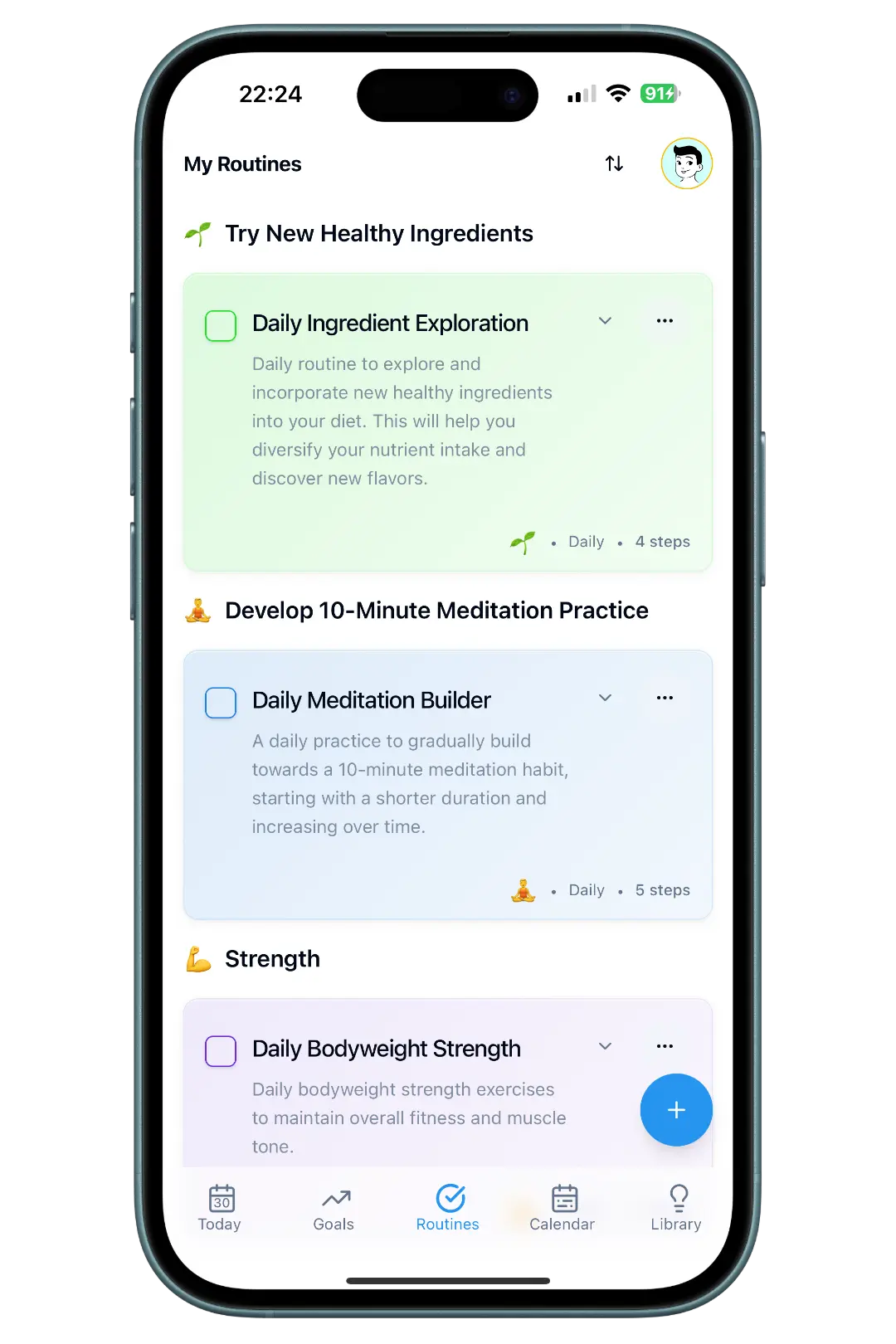
Take Control of Your Health with Smart Planning
February 14, 2025
Most people approach health reactively—waiting until something goes wrong, then scrambling to fix it. But the healthiest people are strategic planners who take control of their wellness before problems arise. Smart health planning isn't about obsessive control; it's about creating predictable systems that make good health inevitable. Here's how to shift from reactive health management to proactive health mastery.
The Control Paradigm Shift
From Reactive to Proactive Health
Reactive Health Approach:
- Wait until you feel unhealthy to take action
- React to symptoms rather than preventing causes
- Let circumstances dictate your health choices
- Hope for the best while planning for nothing
Proactive Health Approach:
- Plan for optimal health before problems arise
- Address root causes rather than just symptoms
- Control circumstances through strategic planning
- Create systems that make good health predictable
The Smart Planning Advantage
Without smart planning:
- Health choices depend on daily motivation and willpower
- Progress happens randomly and inconsistently
- Setbacks feel devastating and permanent
- Health feels like something that happens to you
With smart planning:
- Health choices become systematic and automatic
- Progress happens predictably through designed systems
- Setbacks become temporary blips in an upward trend
- Health feels like something you actively control
The S.M.A.R.T. Health Control Framework
S - Systematic Assessment
Principle: Take control by understanding exactly where you are and where you want to go.
Comprehensive Health Assessment:
Current State Analysis:
- Physical health: Energy levels, sleep quality, fitness capacity, health markers
- Mental health: Stress levels, mood patterns, cognitive function, emotional resilience
- Lifestyle patterns: Current habits, time allocation, environmental factors
- Support systems: Social connections, professional resources, tools and technology
Vision Clarification:
- Health aspirations: What does optimal health look and feel like for you?
- Priority areas: Which health improvements would most impact your life quality?
- Success metrics: How will you know you're making meaningful progress?
- Timeline expectations: What's realistic progress for your situation?
Gap Analysis:
- Skill gaps: What knowledge or abilities do you need to develop?
- Resource gaps: What tools, support, or investments do you need?
- System gaps: What processes or structures are missing?
- Mindset gaps: What beliefs or attitudes need to shift?
M - Measurable Tracking Systems
Principle: You can only control what you can measure and track effectively.
Multi-Layer Tracking Approach:
Daily Process Metrics (30 seconds):
- Habit completion: Track foundation health practices in ProgressMade
- Energy assessment: Rate physical and mental energy levels
- Mood tracking: Notice emotional patterns and triggers
- Challenge documentation: Record obstacles and how you handled them
Weekly Pattern Analysis (5 minutes):
- Consistency rates: Calculate completion percentages for key health habits
- Trend identification: Notice what's improving vs. what needs attention
- System effectiveness: Evaluate which planning strategies are working
- Adjustment needs: Identify what modifications would improve results
Monthly Outcome Reviews (15 minutes):
- Goal progression: Assess progress toward major health objectives
- System evolution: Refine planning approach based on real-world data
- Resource evaluation: Determine if current tools and support are sufficient
- Strategic planning: Set intentions and focus for the coming month
A - Adaptive Strategy Development
Principle: Smart planning creates flexible systems that adapt to changing circumstances.
Adaptive Planning Elements:
Scenario Planning:
- Best-case scenarios: How to maximize progress when everything goes well
- Average scenarios: Sustainable strategies for typical weeks
- Worst-case scenarios: Minimum viable practices for challenging times
- Recovery scenarios: How to get back on track after disruptions
Seasonal Adaptations:
- Energy cycle planning: Align health activities with natural energy rhythms
- Weather adaptations: Indoor/outdoor alternatives for different seasons
- Social calendar integration: Plan around holidays, vacations, busy periods
- Life phase adjustments: Modify approach as circumstances change
Contingency Planning:
- Equipment failures: Backup options when primary tools aren't available
- Schedule disruptions: Alternative time slots and abbreviated routines
- Motivation dips: Systems that work regardless of mood or energy
- Social pressures: Strategies for maintaining health goals in challenging social situations
R - Resource Optimization
Principle: Control your health by strategically deploying available resources for maximum impact.
Resource Categories:
Time Resources:
- High-impact time allocation: Focus time on activities with biggest health returns
- Efficiency maximization: Batch preparation and system automation
- Buffer time creation: Build flexibility into schedules for adaptation
- Energy-time matching: Align demanding activities with high-energy periods
Financial Resources:
- Strategic health investments: Prioritize spending on highest-impact health tools
- Cost-benefit analysis: Evaluate health expenses for actual value delivered
- Budget allocation: Dedicate specific funds to health priorities
- Long-term cost thinking: Consider prevention costs vs. treatment costs
Social Resources:
- Support network building: Cultivate relationships that support health goals
- Professional resources: Strategically use healthcare providers, trainers, coaches
- Community engagement: Join groups and activities aligned with health objectives
- Accountability partnerships: Create mutual support systems for consistency
Knowledge Resources:
- Strategic learning: Focus education on areas with most practical application
- Expert consultation: Know when to seek professional guidance
- Peer learning: Learn from others who've achieved similar health goals
- System documentation: Record what works for future reference and refinement
T - Time-Based Execution
Principle: Control health outcomes through strategic timing and systematic execution.
Execution Strategies:
Daily Execution Framework:
- Morning control routine: Start each day with health-supporting practices
- Midday check-ins: Brief assessments and course corrections
- Evening preparation: Set up tomorrow for health success
- Reflection and logging: End-of-day tracking and system feedback
Weekly Execution Cycles:
- Sunday planning: Week-ahead health strategy and preparation
- Midweek assessment: Wednesday evaluation and adjustment
- Friday review: Week completion analysis and next week preparation
- Weekend balance: Maintain health structure while allowing flexibility
Monthly Execution Phases:
- Week 1: New habit introduction or system enhancement
- Week 2: Consistency building and obstacle identification
- Week 3: System stress-testing and refinement
- Week 4: Assessment, planning, and preparation for next month
Smart Planning Implementation Guide
Phase 1: Assessment and Strategy (Days 1-7)
Day 1-2: Comprehensive Assessment
- Complete health status evaluation across all dimensions
- Identify biggest opportunities for health improvement
- Document current habits and patterns in ProgressMade
- Assess available resources (time, money, support, knowledge)
Day 3-4: Vision and Goal Setting
- Define specific, measurable health objectives
- Prioritize goals based on impact and feasibility
- Create success metrics and tracking systems
- Set realistic but challenging timelines
Day 5-7: Strategy Development
- Design systems for achieving priority health goals
- Create contingency plans for common obstacles
- Identify resource requirements and acquisition plans
- Begin implementing foundation planning practices
Phase 2: System Building (Days 8-21)
Week 2: Foundation Construction
- Implement daily tracking and assessment routines
- Build core health habits with systematic progression
- Test and refine planning systems based on real-world feedback
- Establish weekly and monthly review rhythms
Week 3: Integration and Optimization
- Connect individual health practices into cohesive systems
- Optimize timing and resource allocation based on experience
- Add social and environmental support elements
- Practice adaptation and contingency protocols
Phase 3: Mastery and Evolution (Days 22-30)
Week 4: Advanced Implementation
- Fine-tune all system elements for maximum effectiveness
- Build long-term sustainability into planning approach
- Document lessons learned and best practices
- Plan next month's advancement and evolution
Ongoing Mastery:
- Continuous system refinement based on data and experience
- Strategic expansion into new health areas
- Leadership and teaching opportunities to reinforce learning
- Long-term vision realization through systematic progress
Advanced Smart Planning Strategies
Predictive Health Planning
- Pattern recognition: Use tracking data to predict challenges and opportunities
- Seasonal planning: Anticipate and prepare for predictable health challenges
- Life event planning: Modify health systems for major life changes
- Aging considerations: Adapt planning approach for different life stages
Systems Integration
- Health-life integration: Align health planning with career and family goals
- Technology leverage: Use digital tools to enhance planning effectiveness
- Professional integration: Coordinate with healthcare providers for optimal outcomes
- Community building: Create or join communities that support smart health planning
Innovation and Experimentation
- Controlled experimentation: Test new approaches systematically
- Best practice adoption: Incorporate proven strategies from others
- Personal optimization: Customize approaches for your unique situation
- Continuous improvement: Regular evolution of planning sophistication
Common Smart Planning Mistakes
Mistake 1: Over-Planning
Problem: Creating such complex plans that execution becomes impossible Solution: Start simple and add complexity gradually as systems prove effective
Mistake 2: Under-Adapting
Problem: Rigid plans that break when circumstances change Solution: Build flexibility and adaptation into all planning systems
Mistake 3: Measurement Overload
Problem: Tracking so many metrics that the process becomes burdensome Solution: Focus on essential metrics that drive decision-making and motivation
Mistake 4: Isolation Planning
Problem: Developing health plans without considering social and environmental factors Solution: Integrate planning with all aspects of life for sustainable success
Your Smart Planning Action Steps
This Week:
- Complete comprehensive health assessment
- Set up systematic tracking in ProgressMade
- Identify your highest-impact health opportunities
- Create your first adaptive planning framework
This Month:
- Build and test integrated health systems
- Develop contingency plans for common obstacles
- Optimize resource allocation for maximum health impact
- Establish monthly planning and review rhythms
This Quarter:
- Refine planning sophistication based on results
- Expand planning into new health areas
- Build teaching and leadership opportunities
- Plan long-term health trajectory and milestones
The Smart Planning Promise
When you take control of your health through smart planning, you transform from someone who hopes for good health to someone who systematically creates it. You become the architect of your wellness rather than the victim of circumstances.
Smart health planning gives you:
- Predictable progress: Systems that create consistent results
- Stress reduction: Confidence that comes from being prepared
- Resource efficiency: Maximum health returns on time and energy investment
- Long-term success: Sustainable approaches that work for decades, not just months
Stop leaving your health to chance. Start planning for the wellness you want to create.
Your health is too important to manage reactively. Take control today through smart, strategic planning.
What aspect of your health will you take control of first?
